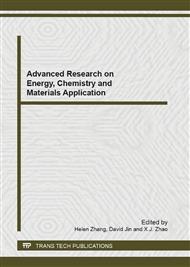[1]
B. Giechaskiel, B. Alfoldy, Y. Drossinosa. A metric for health effects studies of diesel exhaust particles. Aerosol Science, 2009(40): 639-651.
DOI: 10.1016/j.jaerosci.2009.04.008
Google Scholar
[2]
Abderrahim Nemmar, Suhail Al-Salam, Subramanian Dhanasekaran, et al. Pulmonary exposure to diesel exhaust particles promotes cerebral microvessel thrombosis: Protective effect of a cysteine prodrug L-2-oxothiazolidine-4-carboxylic acid. Toxicology 2009, 263: 84-92.
DOI: 10.1016/j.tox.2009.06.017
Google Scholar
[3]
Cheng Huang, Diming Lou, Zhiyuan Hu, et al. Ultrafine particle emission characteristics of diesel engine by on-board and test bench measurement. Journal of Environmental Sciences, 2012, 24(11): 1972-(1978).
DOI: 10.1016/s1001-0742(11)61038-3
Google Scholar
[4]
Frank J. Kelly*, Julia C. Fussell. Size, source and chemical composition as determinants of toxicity attributable to ambient particulate matter. Atmospheric Environment 2012, 60: 504-526.
DOI: 10.1016/j.atmosenv.2012.06.039
Google Scholar
[5]
Oberdörster G, Ferin J, Lehnert BE. Correlation between particle size and in vivo particle persistence and lung injury. Environmental Health Perspective, 1994, 102(5): 173-179.
DOI: 10.1289/ehp.94102s5173
Google Scholar
[6]
Peters A, Wichmann HE, Tuch T, et al. Respiratory effects are associated with the number of ultrafine particles. American Journal of Respiratory and Critical Care Medicine, 1997, 155(4): 1376-1383.
DOI: 10.1164/ajrccm.155.4.9105082
Google Scholar
[7]
Nygaard UC, Samuelsen U, Aase A, et al. The capacity of particles to increase allergic sensitization is predicted by particle number and surface area, not by particle mass. Toxicol Science, 2004, 82: 515-524.
DOI: 10.1093/toxsci/kfh287
Google Scholar
[8]
Kevin Hallstrom, Jefferson M. Schiavon. Euro IV and V diesel emission control system review. SAE Paper 2007-01-2617.
DOI: 10.4271/2007-01-2617
Google Scholar
[9]
Sougato Chatterjee, Andrew P. Walker, Philip G. Blakeman. Emission Control Options to Achieve Euro IV and Euro V on Heavy Duty Diesel Engines. SAE Paper 2008-28-0021.
DOI: 10.4271/2008-28-0021
Google Scholar
[10]
Athanasios Mamakos, GiorgioMartini, UrbanoManfredi. Assessment of the legislated particle number measurement procedure for a Euro5 and a Euro6 compliant diesel passenger cars under regulated and unregulated conditions. Journal of Aerosol Science 2013, 55: 31-47.
DOI: 10.1016/j.jaerosci.2012.07.012
Google Scholar
[11]
M. F. Milazzo, F. Spina, P. Primerano, et al. Soy biodiesel pathways: Global prospects. Renewable and Sustainable Energy Reviews 2013, 26: 579-624.
DOI: 10.1016/j.rser.2013.05.056
Google Scholar
[12]
Georgios Fontaras, Georgios Karavalakis, Marina Kousoulidou, et al. Effects of biodiesel on passenger car fuel consumption, regulated and non-regulated pollutant emissions over legislated and real-world driving cycles. Fuel, 2009, 88: 1608-1617.
DOI: 10.1016/j.fuel.2009.02.011
Google Scholar
[13]
Marina Kousoulidou, Georgios Fontaras , Leonidas Ntziachristos, et al. Evaluation of biodiesel blends on the performance and emissions of a common-rail light-duty engine and vehicle. SAE Paper 2009-01-0692.
DOI: 10.4271/2009-01-0692
Google Scholar
[14]
Piqiang Tan, Diming Lou, Zhiyuan Hu. Nucleation mode particle emissions from a diesel engine with biodiesel and petroleum diesel fuels. SAE Paper 2010-01-0787.
DOI: 10.4271/2010-01-0787
Google Scholar
[15]
Di Yao, Diming Lou, Zhiyuan Hu, et al. Experimental investigation on particle number and size distribution of a common rail diesel engine fueling with alternative blended diesel fuels. SAE Paper 2011-01-0620.
DOI: 10.4271/2011-01-0620
Google Scholar


